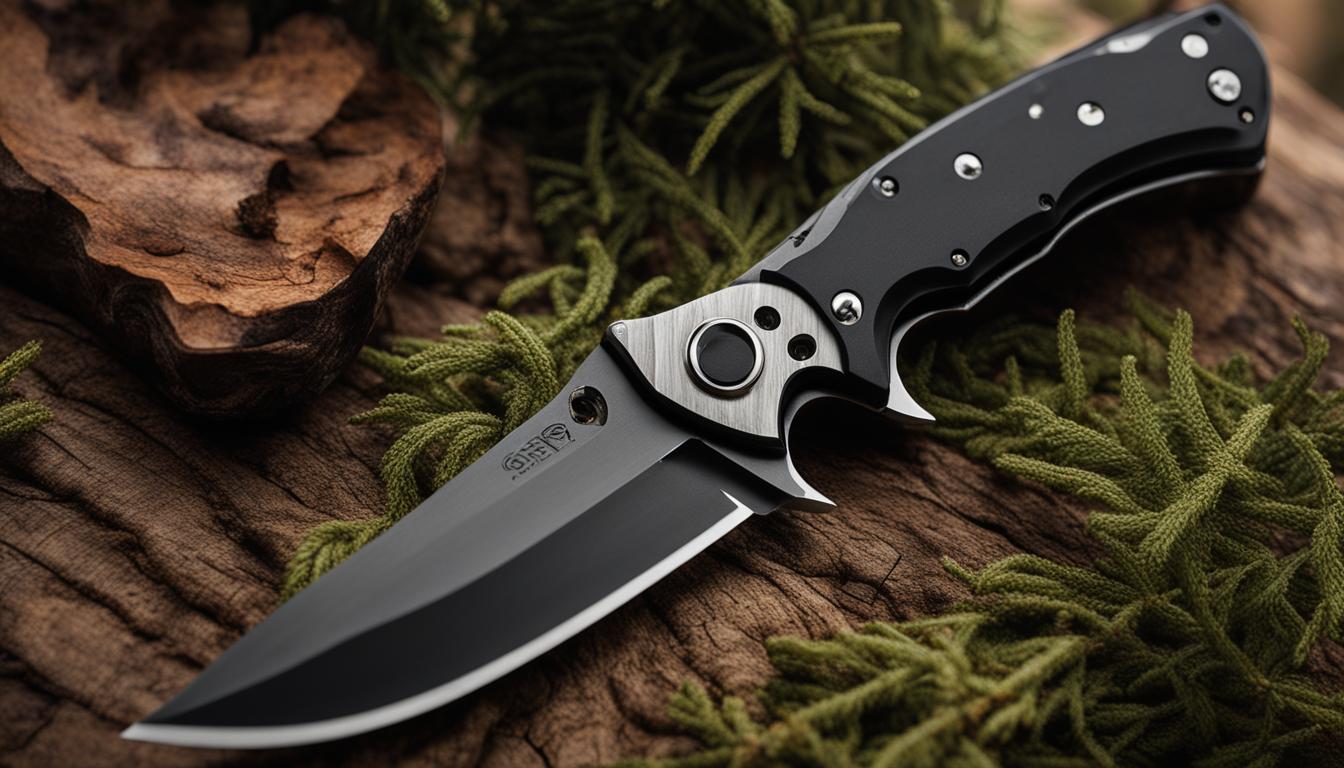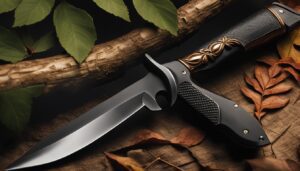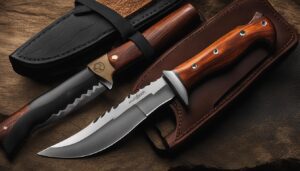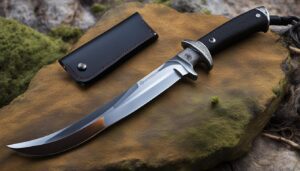A hunting knife is an essential tool for any outdoor enthusiast. Whether you’re a seasoned hunter or a newbie exploring the wilderness, having a reliable and high-performance folding hunting knife can make all the difference in your adventures. In this comprehensive guide, I will walk you through everything you need to know to find the best folding hunting knife that suits your needs and preferences.
Key Takeaways:
- Choosing the right folding hunting knife is crucial for outdoor enthusiasts.
- Consider factors like blade shape, material, handle, and the debate between fixed and folding knives.
- Weight, balance, sheath, and maintenance are important considerations.
- Proper care and use of your folding hunting knife will ensure longevity and performance.
- With the right folding hunting knife, you can confidently embark on your outdoor adventures.
Understanding the Anatomy of a Hunting Knife
When it comes to choosing a folding hunting knife, understanding its anatomy is essential. Each component plays a crucial role in the knife’s performance and suitability for different tasks. Let’s dive into the key aspects to consider:
Blade Shape
The blade shape significantly affects the knife’s functionality. Whether it’s a clip point, drop point, or gut hook, each shape has its advantages. A clip point offers versatility and precision, while a drop point provides strength and control. A gut hook is ideal for field dressing game.
Blade Material
The blade material determines the knife’s durability and maintenance requirements. Stainless steel blades are resistant to corrosion and require less upkeep. Carbon steel blades are exceptionally sharp and easier to sharpen, but they may be more prone to rust if not properly cared for.
Handle Considerations
The handle is vital for a secure grip and comfortable use. Whether made of synthetic or natural materials, it should provide sufficient grip, even in wet conditions. Consider an ergonomic handle design to minimize hand fatigue during extended use.
Tang, Blade Grind, and Edge Retention
The tang refers to the part of the blade that extends into the handle. A full tang, where the blade runs the entire length of the handle, offers excellent strength and stability. Blade grind determines the thickness of the blade, impacting its cutting ability. Finally, edge retention refers to how well the blade maintains its sharpness over time.
| Blade Shape | Advantages |
|---|---|
| Clip Point | Versatility and precision |
| Drop Point | Strength and control |
| Gut Hook | Ideal for field dressing game |
| Blade Material | Characteristics |
|---|---|
| Stainless Steel | Corrosion-resistant, low maintenance |
| Carbon Steel | Sharp, easier to sharpen, rust-prone if not cared for |
Choosing a hunting knife with the right blade shape, material, and handle considerations is crucial for a successful hunting experience. Each component plays a vital role in the knife’s overall performance and functionality.
Fixed vs. Folding Knives: The Debate
When it comes to choosing a hunting knife, one of the most debated topics is whether to opt for a fixed knife or a folding knife. Both options have their own advantages and considerations, making it essential to understand the key differences before making a decision.
Portability and Size Options
Folding knives are highly favored for their portability. They are designed to fold into a compact size, making them easy to carry in your pocket or backpack. This convenience allows hunters to have their knife readily accessible whenever needed. Additionally, folding knives offer a variety of size options, allowing users to select one that best suits their preferences and intended purpose.
On the other hand, fixed knives are generally larger and bulkier. While this may limit their portability, they offer increased strength and durability to handle heavy-duty tasks. Fixed knives are the preferred choice for hunters who require a robust blade that can withstand demanding conditions.
Strength, Ease of Carry, and Deployment Time
Fixed knives are renowned for their strength and reliability. As the blade extends into the handle without any moving parts, they are more robust and less susceptible to failure. This makes them ideal for tasks that involve cutting through tough materials or applying force. Fixed knives are also easier to carry on the belt or in a sheath, ensuring quick access when needed. However, it’s important to note that fixed knives require a sheath for safe storage and transport.
Folding knives, while not as sturdy as fixed knives, offer a range of benefits. They are lightweight, making them incredibly easy to carry and less burdensome during long hunting trips. These knives often feature one-handed opening mechanisms, allowing for quick and effortless deployment. However, the folding mechanism introduces moving parts, which may require occasional maintenance and proper care to ensure smooth operation.
Maintenance Considerations
Maintenance is another factor to consider when choosing between fixed and folding knives. Fixed knives are typically easier to clean and maintain due to their simple design. They do not have moving parts that can accumulate dirt or debris. A fixed blade can be cleaned with water and mild soap, dried thoroughly, and then oiled to prevent rusting.
While folding knives require more attention to keep them in optimal condition, regular maintenance is not overly complicated. It’s crucial to clean the knife thoroughly, paying close attention to the pivot area and ensuring all debris is removed. Proper lubrication of the moving parts will support smooth opening and closing. Folding knives also require periodic inspection to detect any signs of wear and tear, allowing for timely repairs or adjustments.
| Fixed Knife | Folding Knife | |
|---|---|---|
| Portability | Less portable due to larger size | Highly portable, easy to carry in pocket or backpack |
| Strength | More sturdy and durable | Less sturdy than fixed knives |
| Ease of Carry | Carried on belt or in sheath | Lightweight and easy to carry |
| Deployment Time | Quick and immediate access | Requires unfolding before use |
| Maintenance | Simple and easy to clean, less maintenance required | Requires periodic cleaning, lubrication, and inspection |
Ultimately, the decision between a fixed knife and a folding knife depends on personal preferences and specific hunting requirements. Consider factors such as portability, strength, ease of carry, deployment time, and maintenance to make an informed choice. Both options have their own merits, and selecting the right knife can greatly enhance your hunting experience.
Considerations for the Perfect Folding Hunting Knife
When selecting the perfect folding hunting knife, several key factors should be taken into consideration to ensure optimal performance and usability. These factors include weight and balance, the type of sheath, blade coatings and treatments, ergonomic handle designs, and innovative sheath designs. By carefully evaluating these aspects, you can find a folding hunting knife that meets your specific needs and enhances your outdoor adventures.
Weight and Balance
Weight and balance are crucial considerations when choosing a folding hunting knife. A well-balanced knife ensures comfortable handling and maneuverability, allowing for precise cutting and minimizing fatigue during extended use. The weight of the knife should be appropriate for your intended tasks and personal preferences. While a heavier knife offers more power, a lighter one may be less tiring over time.
Sheath
The sheath is an essential accessory for a folding hunting knife as it provides protection for the blade and allows for safe and easy access. When evaluating sheaths, consider factors such as durability, ease of use, and compatibility with your preferred carry method. Innovative sheath designs, such as those with quick-release mechanisms or multi-carry options, can significantly enhance the functionality and convenience of your folding hunting knife.
Blade Coatings and Treatments
Blade coatings and treatments can enhance both the performance and aesthetics of a folding hunting knife. Coatings such as ceramic or DLC (Diamond-Like Carbon) can improve the blade’s durability, corrosion resistance, and ease of cleaning. Treatments like cryogenic tempering or acid etching can enhance the blade’s hardness and edge retention, making it more effective for various cutting tasks.
Ergonomic Handle Designs
An ergonomic handle design is crucial for a comfortable and secure grip, ensuring precise control and reducing the risk of hand fatigue or slippage. Consider handles with contoured shapes, textured surfaces, or finger grooves that provide a natural fit and excellent traction. Synthetic materials like G10 or rubberized grips may offer durability, while natural materials like wood or stag horn can add a touch of elegance to your folding hunting knife.
Innovative Sheath Designs
In addition to traditional sheaths, innovative designs can provide added functionality and convenience. Look for features like belt clips, belt loops, or MOLLE compatibility for versatile carry options. Some sheaths may also incorporate additional storage compartments for small accessories like fire starters or sharpening tools, allowing you to have essential items readily accessible while keeping your folding hunting knife secure.
By considering the weight and balance, sheath options, blade coatings and treatments, ergonomic handle designs, and innovative sheath designs, you can make an informed decision when selecting your perfect folding hunting knife. These factors contribute to the overall performance, durability, and user experience, ensuring that your knife becomes a reliable companion for your outdoor pursuits.
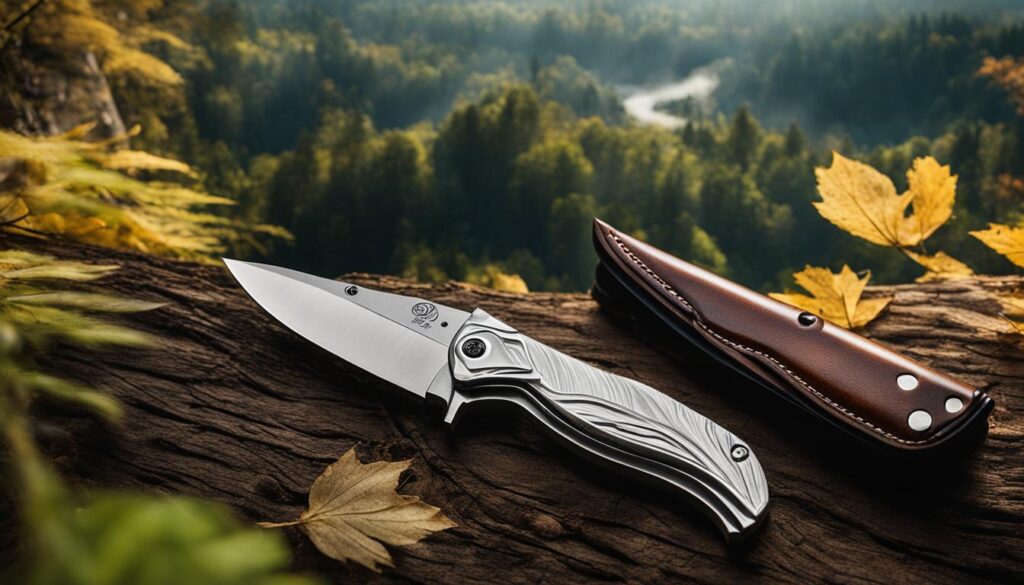
Maintaining and Caring for Your Folding Hunting Knife
Proper maintenance and care are crucial for ensuring the longevity and performance of your folding hunting knife. By following these essential practices, you can keep your knife in top condition, ready for any outdoor adventure.
Regular Cleaning
Regularly cleaning your folding hunting knife is vital to remove dirt, debris, and moisture that can cause corrosion and damage. Use soap and water to clean the blade, handle, and all other parts of the knife. Ensure that you dry the knife thoroughly after cleaning to prevent rust formation. A clean knife not only performs better but also prolongs its lifespan.
Proper Sharpening
Keeping your folding hunting knife sharp is essential for efficient cutting and slicing. Use appropriate sharpening tools like whetstones or honing rods to maintain a sharp edge. Follow the manufacturer’s instructions or seek professional guidance to ensure you sharpen the blade at the correct angle. Regular sharpening will not only enhance the knife’s performance but also reduce the risk of accidents caused by a dull blade.
Rust Prevention
Rust is the arch-nemesis of any hunting knife. To prevent rust formation, apply a light coat of oil to the blade after cleaning. The oil acts as a protective barrier, shielding the metal from moisture and humidity. Make sure to use a rust-preventive oil suitable for the type of steel used in your knife. Regularly inspect the knife for any signs of rust and address the issue promptly to avoid further damage.
Storage and Regular Inspections
Proper storage is essential to maintain the condition of your folding hunting knife. Store it in a dry place, away from moisture and extreme temperatures, to prevent corrosion. Additionally, it’s crucial to regularly inspect your knife for wear, damage, or loose components. Pay close attention to the locking mechanism and ensure it is functioning properly. Any issues should be addressed promptly to prevent further damage and ensure safe operation.
Professional Servicing and Proper Use
If your folding hunting knife requires professional servicing or repair, it’s best to seek assistance from a reputable knife specialist. They can restore the blade’s edge, fix any handle issues, or address other maintenance needs. Lastly, always use your hunting knife for its intended purpose and follow proper safety guidelines. Misuse and improper handling can lead to accidents and damage to the knife.
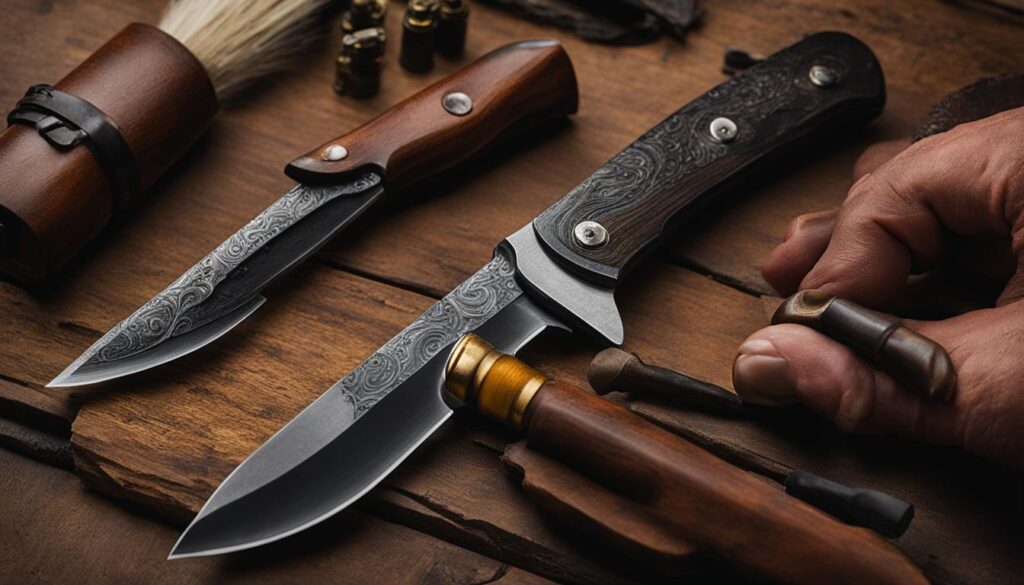

By following these essential maintenance and care practices, you can ensure that your folding hunting knife remains reliable, functional, and ready for your next outdoor adventure.
Conclusion
After exploring the factors to consider when choosing a folding hunting knife, understanding its anatomy, and evaluating the debate between fixed and folding knives, it’s time to make your decision. Remember, the best folding hunting knife is the one that suits your specific needs and preferences.
By prioritizing quality craftsmanship and taking into account key factors like weight, balance, and maintenance, you can find the perfect folding hunting knife for your outdoor adventures. Whether you opt for a clip point or drop point blade, stainless steel or carbon steel, synthetic or natural handle materials, make sure it meets your requirements.
Once you have your folding hunting knife, remember to maintain and care for it properly. Regular cleaning, proper sharpening, rust prevention, and regular inspections are crucial. Additionally, store your knife in a dry place and seek professional servicing when needed. Proper use will also ensure its longevity.
So, equip yourself with the best folding hunting knife, armed with the knowledge from this guide. Whether you are a seasoned hunter or a beginner, having the right tool by your side will enhance your outdoor experience. Happy hunting!
FAQ
What factors should I consider when choosing a folding hunting knife?
When choosing a folding hunting knife, consider factors such as blade shape, material, handle considerations, fixed vs. folding knives, weight and balance, sheath, and maintenance.
What is the difference between a fixed knife and a folding knife?
Fixed knives are generally stronger and more durable, but less portable. Folding knives are highly portable and offer a wide range of size options, but may not be as sturdy and require unfolding before use.
How important is weight and balance in a folding hunting knife?
Weight and balance play a significant role in usability and comfort. A heavier knife may offer more power, but a lighter one will be less tiring over time.
What should I consider when choosing a sheath for my folding hunting knife?
Consider a sheath that provides protection for the blade and allows for easy access. Additionally, look for innovative sheath designs that improve functionality and safety.
How do I properly maintain and care for my folding hunting knife?
Regularly clean the knife with soap and water, ensure it is thoroughly dried to prevent rust, sharpen the blade using appropriate tools, apply a light coat of oil for rust prevention, store the knife in a dry place, regularly inspect for wear or damage, and seek professional servicing if necessary.
